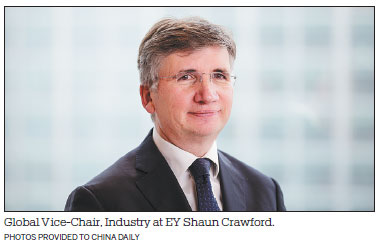Digital technologies help 'build a better working world'
Insights and quality services from EY creating better business trust globally
With its goal of building a better working world, EY provides insights and quality services to create more trust and confidence in the capital markets and in economies around the globe. The company helps organizations make better decisions about their business, finance and technology. Global Vice-Chair, Industry at EY Shaun Crawford recently shared with China Daily his views on EY's NextWave Global Trade initiative and how it will influence the business world.
What role does EY play in building a better working world?
EY plays a critical role in building a better working world for our people, for our clients and for our communities. We work with companies, entrepreneurs and governments to solve their most pressing business challenges, whether that's helping digital pioneers fight data piracy; guiding governments through cashflow crises; unlocking new medical treatments with data analytics; or pursuing high-quality audits to build trust in financial markets and business.
Our NextWave Global Trade initiative is just one example of how we are building a better working world with a number of cross-sector parties, from exporters, banks, insurers, freight forwarders, shipping companies to customs authorities, ports and importers.
How does the EY NextWave Global Trade initiative work?
The need for an efficient and dynamic flow of goods across borders has never been greater, and choke points that create friction are becoming acute.
We embarked on our NextWave Global Trade initiative to help multiple players across the value chain to collaborate and explore how they can shape the future of global trade together. In particular, we started investigating how the better exchange of information, combined with new technologies and collaboration could help remove some of the frictions that slow the movement and potentially boost overall trade.
We are working with organizations to fix what isn't working today while working to build the business they need to be for tomorrow.
How will the NextWave Global Trade initiative help ports solve problems in logistics, prepare for future growth, and thus promote the development of overall trade?
Port logistics is complex and demanding. For major hub ports, there is an increasing variety of vessel sizes and high traffic volume. Port waters and anchorages become congested and higher port productivity is needed while the environmental impacts on air, water and land need to be minimized. In addition, there is a lot of manual processing and paper documentation and data is still hidden or inaccessible.
To address these challenges, ports are creating digital marketplaces that not only digitize the existing communications, but also enable the creation of supply chain and logistics applications.
The NextWave Global Trade initiative facilitates collaboration so that ports can look beyond the traditional port communities to capture and leverage data to trace goods, track real-time operations and plan proactively. In particular, we recognize that alongside technology, trust is essential to facilitate such collaboration and allow communities to share data and work together to boost trade. Insurwave is an example of how we are leveraging technology to create such trust.
Insurwave is a blockchain platform that provides a single source of digital truth for vessels and, shortly, cargo data for better placing marine insurance across shipping companies, brokers and insurers.
Ports and other parties involved in the flow of goods can trust this data from Insurwave networks to improve the customer experience through digital services.
Trusted data lay the foundation for stakeholders to work together and address logistical challenges, ultimately achieving operational efficiency and cost savings.
In China, we are also in discussion with various ports to explore how they can leverage Insurwave as an innovation platform to help deliver marine insurance products, services and technology, as well as support the 21st Century Maritime Silk Road and the Guangdong-Hong Kong-Macao Greater Bay Area plan.
What are the new solutions EY teams are working on and how will these play an important role in transforming how ports work in the trade ecosystem?
EY is constantly identifying and designing new solutions that are based around technology and data. These solutions help our clients adapt and innovate in order to grow in the transformative age.
Similar to Insurwave, we have developed a suite of solutions and capabilities such as digital passport (the permission exchange of digital identity and customer data), tax trade analytics (an analytics solution that improves trade flow) and port optimization simulation tool (powered by AI and machine learning for port operational efficiency).
These solutions allow ports and shipping companies to use advanced technologies to drive disruptive operational changes toward building intelligent ports and attracting further businesses.
For example, we developed the port optimization simulation tool using AI models to analyze more than one billion data points with advanced analytics, machine learning and new sources of data.
This enables an accurate simulation of changes to the number, size and operating strategies of harbor craft - leading to huge gains in performance.
For vessel predictions alone, increased accuracy has led to over $10 million in estimated savings for one of the world's busiest ports. Better planning has also led to more predictable working hours, resulting in a better work-life balance and lower staff turnover. Therefore, we view working with stakeholders across the trade value chain to build an efficient port operation as a critical step in creating a better working world where ports will be autonomous and trade flows frictionlessly.
The views reflected in this article are the views of the author and do not necessarily reflect those of the global EY organization or its member firms.

(China Daily 05/08/2019 page7)














